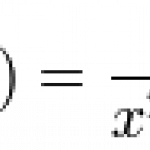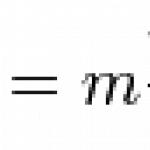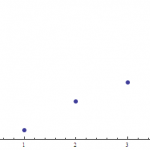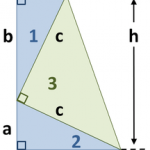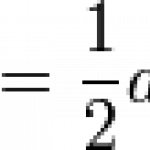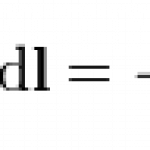
You're taking your morning shower and a thought occurs to you. "In classical electrodynamics, an accelerating charge radiates. In general relativity, acceleration is equivalent to a gravitational field. Therefore a stationary charge should radiate simply by virtue of being in a gravitational field. What's up with that?"
You wonder about what the radiated power would be for a given gravitational field. You figure maybe you could use the Larmor formula with the Stefan-Boltzmann law to estimate the equivalent thermal radiation but you don't remember either one of those equations exactly and you'…
Here's a straightforward function of two variables, x and y:
Its domain is all real x and y, with the single exception of x = y = 0, which would make the denominator 0. But we have experience with functions such as sin(x)/x, where we can find the limiting value as x approaches 0 and just make a fiat declaration that that limit isthe value of the function at the origin. Can we do it here?
Well, let's just tabulate the value of f(x,y) for different values of x close to 0 and see what happens:
f(0.1, 0.1) = 0.0990099
f(0.01, 0.01) = 0.009999
f(0.001, 0.001) = 0.000999999
This suggests that if…
Generally speaking, if you play a movie backwards everything that happens is still physically possible. If I throw you a baseball and you catch it, reversing the video is just the equally plausible situation of you throwing the baseball followed by my catching it. If entropy is changing in the video - e.g., breaking an egg - the time-reversed video will not be especially likely. But it doesn't break the laws of physics.
This is called time-reversal symmetry (sometimes T-symmetry for short). If you're looking at planets orbiting in uniform circular motion about the sun, you know from your…
Death and taxes. And dead is dead, but taxes come in a huge panoply of forms. There's property taxes, excise taxes, sin taxes and income taxes. There's gas taxes and sales taxes and VAT taxes (yeah, I know) and death taxes.
With my politics I'm not a huge fan of any of them, but they are what they are. And every once in a while they produce some interesting math. One of the more interesting taxes, mathematically speaking, is the capital gains tax. It works like this: you invest your money in stocks or bonds or some other investment vehicle. In an ideal world your investment grows in value and…
Whew! Back from a very successful wedding and honeymoon, moving into a new apartment, writing thank-you notes, and all the fun jazz that comes with being newly married.
But hey, we've got to get this blog cranking again at some point, and now's as good a time as any. We'll kick things back off with a letter from a reader,
Scott writes in with a question:
If you have a cubic meter of nothing but highly condensed photons, what would the upper limit on its energy density be? (If there is even a limit.)
Classically there's no theoretical limit on the field strength, though radiation pressure…
This Saturday I'm getting married! The following week I'll be in Barbados relaxing on my honeymoon. While Barbados is a highly developed Caribbean economy with no shortage of internet access, in the interests of relaxation and matrimonial bliss I shall not be online. Posting will resume the following week.
Until then, I'll leave you with this Wired article about a wind-powered car that travels directly downwind faster than the wind. When I first read the idea, I thought "No, that's an obvious violation of the laws of nature and everyone involved is an idiot." Well, the proof is in the pudding…
If you go to the bank and open a savings account, the banker might tell you about the virtues of compound interest. He may say something like "Even if you never deposit anything, the rate of change of the money in your account is proportional to the amount of money in your account. The more you earn, the faster you earn." Now the banker is less likely to use such explicitly mathematical language, but what he's telling you is actually a differential equation. A differential equation is an equation that relates a quantity to the rate of change of that quantity. The banker is relating your…
If you take a flashlight and shine it at a wall or through a prism or do pretty much anything with the light, you'll find that the effects of the light change in direct proportion to the amount of light the flashlight's putting out. Twice the light, twice the reflection from the wall. Twice the light, twice the brightness in each color component of the prism spectrum. Nothing really changes qualitatively as you change the light intensity, the only difference is quantitative.
This property of light is called linear optics. Until the last half-century or so it was just called "optics". The…
Here's an odd little bit of math for you this Sunday. It's defined in terms of recurrence. Recurrence happens when a function is defined in terms of itself. This happens more than you might think - one famous example is the Fibonacci sequence, which is informally defined by saying "To get the next term in the sequence, add the previous two terms together. The first two terms are 1 and 1." And so you can calculate that the sequence is {1, 1, 2, 3, 5, 8, 13, 21...} and so forth. That sequence turns out to show up in various odd places in math and science, and recursively defined sequences are…
A few days ago there was an interesting math problem posed on the right-leaning lawprof blog The Volokh Conspiracy. It's a cute problem in itself, and it makes a nice discussion example about the role of computers in modern physics. The problem is this:
Find a ten-digit number with the following two properties (in base 10, of course): A. The number contains each digit (from 0 to 9) exactly once. B. For every N from 1 to 10, the first N digits of the number are divisible by N.
Thus, for instance, 1234567890 doesn't work; while 1 is divisible by 1, 12 is divisible by 2, and 123 is divisible by…
Because I'm a bad busy person, this review of Chad Orzel's How to Teach Physics to Your Dog is only, oh, about 8 months late. You have probably all bought it already. But in case you haven't, I'll tell you what you're getting into.
If you wander over to your local bookstore's science section, you'll see plenty of physics books. There's the standard pontifications by string and high-energy theorists, there's "The Physics of [pop culture fad]" books, there's probably some egregious pseudoscience ("Heal your hernias with positive quantum thinking!"), and if you're in a college town probably…
The new academic year is starting, and if there's one thing students love it's a good word problem. If Sue is four times as old as John will be when Sue is one year than John... So in that spirit I was amused to find basically this kind of problem in a college physics textbook I was perusing for post ideas as I get back into the swing of blogging. It runs thusly:
A father racing his son has half the kinetic energy of the son, who has half the mass of the father. The father speeds up by 1.0 m/s and then has the same kinetic energy as the son. What are the original speeds of the father and the…
So I spent two weeks in Wyoming, participated in a wedding in Louisiana, moved two apartments worth of stuff, visited Louisiana again to get a marriage license for myself (20 days left!), collected data for an experiment demonstrating a new result we're trying to get published quickly (hot topic, lots of competition), and so forth. Blogging is fun, but in terms of priority it has been taking a backseat.
For some reason, I feel the Busy Beaver function might be a good topic for this Sunday...
Ok, consider a Turing machine. I've embedded a video of a guy who's actually built one, but so you'll…
I've been in Casper Wyoming the last few days at the Workshop of Quantum Science and Engineering, put together by Dr. Marlan Scully. The point of the workshop is to discuss the various work we're doing, exchange ideas, and all the other stuff that usually happens at these physics shindigs. We've also had a few talks celebrating 50 years of the laser and 95 years of its inventor, the Nobel laureate legend Dr. Charles Hard Townes. Dr. Scully says he's the greatest living scientist, and I have to say I think he's got a pretty good case.
Casper, Wyoming is Dr. Scully's hometown, and he makes sure…
It's a pretty nice time for quantum optics and laser physics at Texas A&M, with us moving into a brand new lab and acquiring several new laser systems. One of the systems we're moving isn't new (we've had it for a few years, and the technology is considerably older), but we're about to put it to work on a new project. It's a relatively high-power Nd:YAG laser.
The operating parameters are about 2.5 joules per pulse, with 10 pulses per second for an average power of 25 watts. Each pulse is about 8 nanoseconds long. This is a rather hefty amount of light. Though any Class 4 laser requires…
Again, apologies for the hideously scanty posting. Been in the lab doing some really interesting research which will with some luck get me in a really nice journal, as well as doing the various rounds of revision on the paper for some previous research. Also putting two talks together for a conference/school. That whole wedding planning ain't doing wonders for my spare time either. But hey, these are all good things so I'm not complaining.
I can at least write up a Sunday Function for y'all. This is one we've mentioned before, but haven't actually derived. I think it's high time we did. As…
Happy birthday to the United States! It's one of the younger countries on the planet and yet has still managed to have one of the oldest continuous systems of government. Not too shabby. Here's hoping our current wobbles get straightened out and our next few Independence Days occur under more pleasant conditions.
I'm not sure what function might fit very well in the context of this holiday, but I'll make sort of a stretch and do a function about the Pythagorean theorem. The Pythagorean theorem is a very ancient discovery with numerous different methods of proof. One of them was discovered by…
The laser pointer, much beloved of PowerPoint lecturers, cat owners, amateur scientists, and middle school boys at movie theaters, is actually a pretty amazing device. There's quite a bit you can do with a relatively cheap laser, and they're just plain fun. They're also relatively safe. The red pointers are usually Class 2 and the green ones are usualy class 3R. Class 2 lasers are very difficult to hurt yourself with, and while Class 3R lasers can cause eye injury, in general brief exposures are unlikely to cause permanant damage.
There's two higher classifications for lasers: 3B and 4. Class…
I'm not normally much of a soccer fan, but the World Cup doesn't happen every day and it's pretty interesting to see all the excitement and high level of play. I personally think the rules need a little tweaking to reduce the tendency toward 0-0 and 1-1 ties, but I suppose the sport couldn't have so many billions of fans without doing something right.
In honor of the World Cup, let's do a quick example of just how tough the game can be. In soccer of course the players are generally prohibited from touching the ball with their hands - hence, football in most of the world. But in fact the…
On a web forum I frequent, a person asked if it would be possible to extract energy from the Earth's magnetic field. He was told no - static magnetic fields can't transfer energy. For all practical purposes this is true, but in fact we also know that the earth's magnetic field isn't static. It changes from day to day and from year to year - and even second to second. The changes are small over small timescales, but in fact the magnetic poles do drift around and the solar wind does perturb the fields and so forth.
Wikipedia gives a reference saying that typical local variations in the magnetic…

